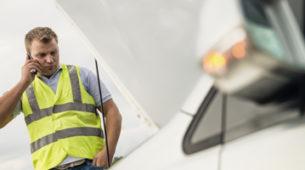
Struck-by vehicle accidents are one of the leading causes of construction-related deaths. In fact, one-in-four struck-by deaths involve construction workers, significantly more than any other occupation. Whether you work in construction, or simply find yourself roadside with a disabled vehicle, it’s important to keep the following safety tips in mind.
Construction Site Safety
- Wear seat belts that meet OSHA standards, except on equipment that is designed for standup operation or that has no rollover protective structure.
- Check vehicles before each shift to assure that all parts and accessories are in safe operating condition.
- Do not drive a vehicle in reverse gear with an obstructed rear view, unless it has an audible reverse alarm, or another worker signals that it is safe.
- Drive vehicles or equipment only on roadways or grades that are safely constructed and maintained.
- Make sure that you and all other personnel are in the clear before using dumping or lifting devices.
- Set parking brakes when vehicles and equipment are parked, and chock the wheels if they are on an incline.
- Use traffic signs, barricades or flaggers when construction takes place near public roadways.
- Workers must be highly visible in all levels of light. Warning clothing, such as red or orange vests, are required; and if worn for night work, must contain reflective material.
Roadside Tips
- Pull onto the shoulder and stop as far off the road as possible with the wheels turned to the right.
- Leave your sidelights on and turn on the hazard warning lights.
- If you have reflective jackets in the vehicle, wear them.
- Once you leave the vehicle, retreat up the bank or behind a barrier, if possible. Always exit on the side opposite the roadway.
- Don’t attempt even simple repairs.
- Motorway hard shoulders are for emergency use only. It’s best to drive to a safer place off the motorway, if possible. Never stop on the shoulder to go to the bathroom, make a phone call or check a route or map.
Calling for Assistance
- Once in a safe place use a mobile phone to call roadside assistance (offered through most insurance carriers or AAA).
- If you don’t have a mobile phone, walk to an emergency telephone on your side of the road – never attempt to cross a highway/interstate.
- If you feel at risk from another person, return to your vehicle and lock all doors. Leave your vehicle again as soon as you feel this danger has passed.
Want to know more?
If you’re an Accident Fund policyholder, log onto our website at AccidentFund.com and check out our WorkSafe Toolbox™ and other available safety tools.
If you’re not a customer, click here for WorkSafe information. Or click here to find an Accident Fund agent near you!
Share this resource:
URL coppied to clipboard.
Or send it directly to someone via our email form:
